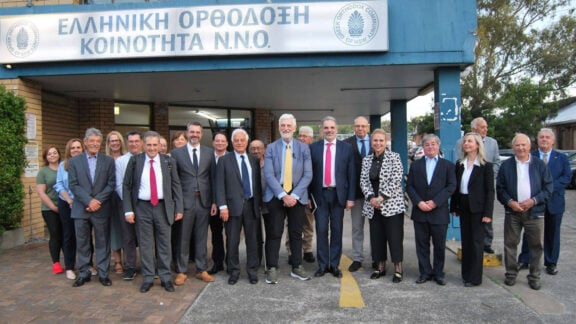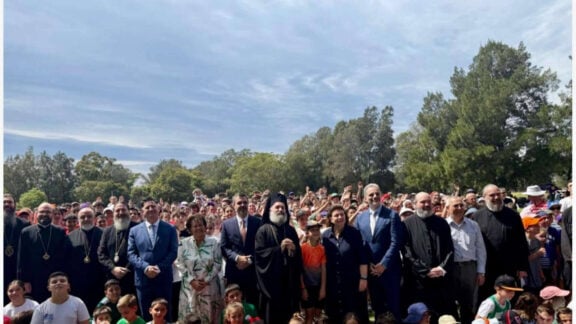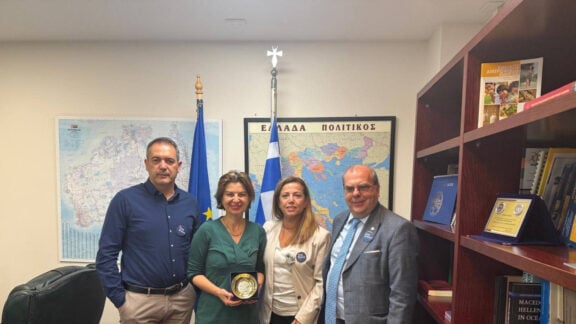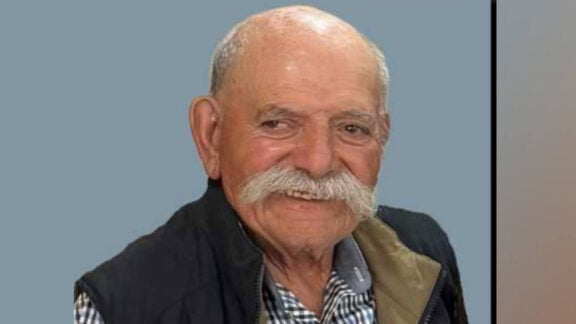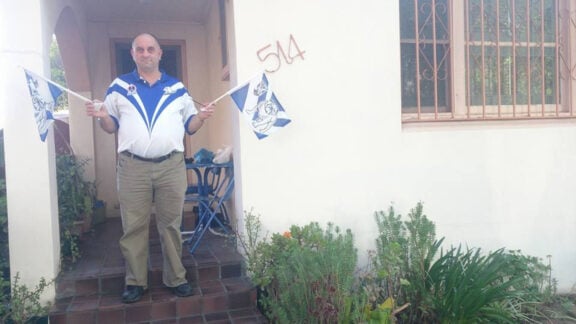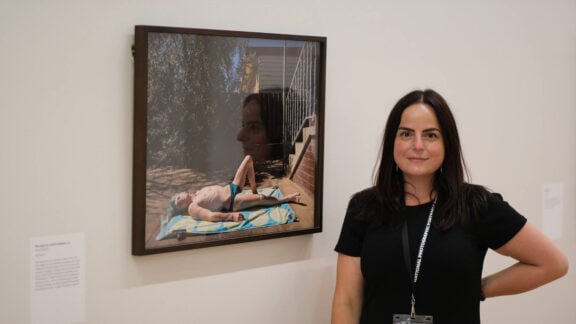My first question, when comparing Melbourne academic Dr Christos Fifis’ latest publications, a poetry collection entitled “From Delphi to Uluru” and the second edition of his “With Lyre and Knowledge: An Overview of the Poetry of Yannis Ritsos”, was this: How are both of these connected, given that the author chose to launch them concurrently in Melbourne on Sunday, 6 April.
At first glance, it can be argued that there is an interest in geography in the works of both poets. In the case of Dr Fifis’ work, Delphi and Uluru are constants for two separate cultures that he tries to connect, or reconcile. Both serve as central axes that support the entire world. In the case of Delphi, this location was considered in times ancient, to be the navel of the earth, its central point. According to the Souda, Delphi took its name from Delphine, the she-serpent (or dragon) that inhabited that location, who was killed by the god Apollo. Thus, the initial process of rendering this spot sacred, involved a struggle, a sacrifice and a death.
It is worthwhile also, when considering Dr Fifis’ attitude to location, to recall the ancient Greek myths about the founding of the Oracle of Delphi. Zeus, in his attempt to locate the centre of the Earth, launched two eagles from the two ends of the world and the eagles, starting at the same time and flying at equal speed, crossed paths over Delphi area, thus determining where the hearthstone was to be placed.
Uluru is also a focal point where the divine and the human converge, and there are several myths associated with it: The first myth tells of snakes that waged many wars around Uluru, marking the rock. The second tells of two tribes of primordial spirits who were invited to a feast, but were distracted by the beautiful Sleepy Lizard Women and did not turn up. By was of retribution, the angry hosts sang to life an evil mud sculpture that assumed the form of a dingo. A great battle ensued, which resulted in the deaths of the leaders of both tribes. The earth itself rose in grief over the bloodshed as a bulge, and became Uluru.
We observe two things, a process of pain, slaughter, sacrifice, rivalry and their dialectic perhaps marks the development of the entire world. There are also notable differences which are ultimately cancel themselves out: Ostensibly, Delphi now belongs to history. It is finite. It is a part of our cultural heritage, but in reality, it plays no role in our lives, nor does it influence or determine the way in which we understand our identity. However, it belongs to the place where we derive our origin, of which we are indigenous. It is our place, and consequently, ours is the right to forget it.
Uluru, by way of contrast, an identifying mark and symbol of the indigenous people of Australia, does not belong to those indigenous people. It is located on occupied land. Until recently, it had another name, given to it by colonialists who violently seized the land from its rightful owners. Of course, it is these colonialists who define our attitude to this monument. The indigenous people are called upon to participate in a kind of performance of their culture and beliefs, one that responds to the needs and ideology of the ruling class of the conquerors, thus legitimizing the crime of conquest and, paradoxically, making the vanquished accomplices in this violent act. By focusing their attention on the exotic, on the representational, are they cultivating a kind of amnesia around the events that transpired?
Delphi has also been colonised, not in the least by its sack by the Goths in the early Byzantine era. Yet there are also other commonalities with Uluru. Have not Western imperialists and colonialists appropriated ancient Greek civilization, considering it their own? Here in Australia, where our community actively participates in the maintenance of this amnesia, are we not considered, rather than as a group of Australians who have played an important role in the development of this country, instead, as descendants/symbols of an ancient tradition that has nothing to do with our reality and our presence here?
It is for this reason, that the employment of the term Uluru by the poet Christos Fifis constitutes a revolutionary act, an act of resistance against the status quo that imposes historical and social amnesia, simply because he dares to say things exactly as they are. It is an act of truth, intertextually in dialogue with Ritsos who wrote: “Well, my children, I am now thinking of finding a word to fit the stature of freedom.” Finding the right words to sum up this truth is an act of revolution, an act of freedom.

Returning to Delphi it wis worthwhile seeking to evaluate its continued relevance to the poet, even as an ossified location. One could posit that this is that embedded within its creation, and underpinning the entire world, is an act of evil. This is directly referred to in Dr Fifis’ poem “The Dark Dragon of the Century”. In Delphi, the dragon was the Delphine. However, the poet informs us that the terrible dragon has had various names throughout the centuries: The Plague of Athens, the Black Death and so many others. Perhaps the main concern of the collection therefore to is a quest to identify this “dragon,” to work out how confront it, and indeed, how to articulate a discourse of resistance.
How does the poet Fifis articulate his discourse: simply, amicably, reflectively, in the style of a Ritsos who is convinced that there are some constant, Ulurus that remain outside the world of decay, to emerge in defiance at the injustice of the world: “I don’t need to shout for them to believe me, to say: “Whoever shouts has justice on his side”. Justice is with us and we know it. And no matter how softly I speak to you, I know you will believe me.”
Dr Fifis writes in his poem “A Ballad for the Australian Killed in the Battle of Crete” that he “confesses that he writes a multitude of words, for a silent Australian.” Evidently, he gives a voice to those who cannot, for whatever reason, speak for themselves. He awakens them, even from the torpor of death and empowers them.
With a colossal vision bestriding both Australia and Greece, the poet Dr Fifis draws his inspiration from the travails of everyday life, the timeless flow of Greek history, especially our own local community history, our social struggles, especially those of the progressive wing of the Greek community, and he begin to composes poetry, lending to his poetics the characteristics of his own life that can be summarized in one word: the search for and articulation of truth. Yannis Ritsos did something similar. Like Dr Fifis, he sought to “find those words that take on the same weight/In all hearts/On all lips/So that we may call /a fig, a fig/ And a kneading trough, a kneading trough.”
In his poem “The invaders came dressed in the sheepskins of peace” Dr Fifis echoes this broad aim, proclaiming: “Poetry should shed light on the facts! It should not put us to sleep! We should not parrot these things!”
As in the case of Ritsos, for Dr Fifis, the spiritual and social awakening of humanity, its integration into the progressive community, the ferment within contemporary social struggles, and the conviction through the socio-cultural events that he observes, are what constitute a source of inspiration and, if nothing else, signal his hopeful belief that we must create a better tomorrow. This is evidenced in his poem: “The struggle is continuous,” dedicated to the memory of Plutarch Deligiannis, which concludes: “His thought frequently raises the question as to how young people will read memories and vision on their own and correctly.” This of course reveals two of his concerns – the struggle but also, and this is simultaneously connected to Delphi and Uluru, how to retain memories and how to understand them correctly. The concept of “correctness” of course, opens up an entirely new discussion, because as the dark dragon of the ages says in Dr Fifis’ poem, “During such periods, the quacks, the frauds and so many other false prophets who know everything multiply.”
In keeping with his aim of retaining lore, the second half of Dr Fifis’ collection is a narrative of his own “walkabout” within ancestral places within Greece. In it, he reflects upon the history, legends and traditions of the places he visits, in a manner akin to the Indigenous Songlines, articulating his own pathways of knowledge, his own “Dreaming Tracks,” that crisscross his poetic world, linking sacred sites and conveying stories of creation, culture, and navigation to the reader.
The process of transcending the divine and delving into the chthonic is replete with romance in Dr Fifis’ poetics, to the extent where the undertones of some of the poems are clearly erotic. They are inspired by the love for humanity that underlies the poet’s consciousness and dialectics. And this is clearly evident in the poem “Coperti”, which suggests that our journey can be a game, it can resemble a scene in play where one enters and the other leaves, but it is this friction that creates memories, that fuels hopes, that sculpts love and creates a new world, one that is evoked with great skill, and even greater humanity, in this remarkable collection of poetry.

